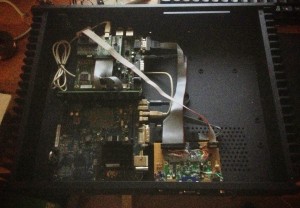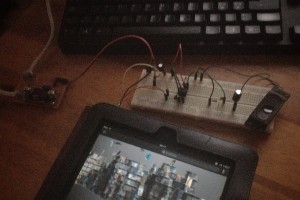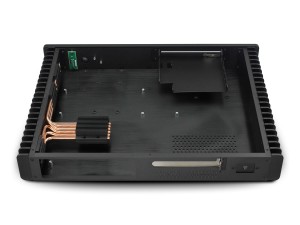Mounting parts inside the chassis.
Plenty of room to spare for remaining parts such as DVD & HDD drives, Voltage regulator, Wifi adapter, internal amp+speaker.

Monthly Archives
Internal speaker
Even though the sound quality is never really that good, I find internal speakers very handy for times when you can’t be bothered connecting up real speakers.
The Mac mini which is donating parts to this project had a speaker so I am experimenting with a tiny low voltage amplifier to drive it.
Here is one built around an LM386N. It’s driven by 5V and I am happy with the volume and quality for what it is.
The small circuit on the left is for getting 5V out of the 18.5V power brick.
Outputs
Output board is getting close to being finished. It will go in the single PCI slot of the computer chassis and provide audio+video output.
A bit simplified, it is based an a no-name KVM switch that has been butchered, modified and fixed to a PCI backplate.
It’s a good thing it goes inside of the case.. it won’t win any beauty contests that’s for sure!
- VGA
- Switchable between PPC / 68K
- Controlled by software, or using the hardware switch on back
- Audio line out
- Mixed audio from PPC + 68K
- Enables internal speaker when no external plug is connected (small amp+speaker setup yet to be built)
- 2x USB
- Connected to PPC
- Misc
- 10 pins for connecting to interface board (4pins used)
Chassis
After having spent a lot of time hunting for a nice chassis for the computer I finally found the perfect one for me.
It is a Streacom FC5OD desktop model:
I really like the looks of it, and size wise it suits really well for hosting the powerpc + minimig + other stuff.
The chassis has arrived and it is a thing of beauty!
I have not yet started to put any hardware inside of it as it is much easier to have the boards loose on the work table for now. Test fittings show that it should work out really well once I’ve drilled out mounting holes for the mainboards etc.
Also waiting for a 44pin HDD cable from Amigakit so that I can relocate HDD. The mac motherboard is going to be mounted “bare” which means that the original mount for the HDD is not going to be available.
I took the opportunity to order a black background boing-ball case badge as well. I may or may not use it.
Hello world!
First post, and a recap of what has been done so far.
Prototype interface board has been built. It is based around an Arduino compatible Teensy++ development board which contains a AT90USB1286 microcontroller.
The main reason why I went for the Teensy instead of any other Arduino compatible board was the transfer rate of the USB compared to the real Arduino boards (benchmark).
There is a PIC processor on the Minimig which acts as an IO controller. This is convenient since I could just remove it and use the socket as an input for my board. The PIC processor itself was relocated to sit on the interface board instead.
Here it is all soldered up:
And connected in the PIC socket of the Minimig:
The interface board is the glue which binds the Minimig together with the PowerPC. I can talk to it from MorphOS over USB, and it in turn can control the Minimig and the VGA switcher hardware.
So far I can power the Minimig on and off, reset it, and feed it with mouse/keyboard/gamepad input coming from the MorphOS side. It can also control a VGA switch to switch between displaying MorphOS and the Minimig on my monitor.
A video of the thing running:
https://www.youtube.com/watch?v=PABMGhbiElY
Next up on the software side is to control floppy disk mount/unmount and in the long run be able to either deploy floppy images to the Minimig SD card and/or “stream” floppy disk content from MorphOS to the Minimig.
There is no risk getting bored with the software side. I get to do MorphOS coding, AVR firmware coding and PIC firmware coding. (In theory I should be able to get rid of the PIC processor and just use the Teensy – to be looked into later)
Hardware is done on prototype board. It would be cool to make proper PCBs when everything is fully finalized but that is still far in the future.





